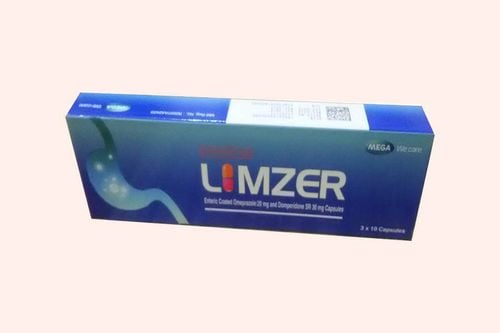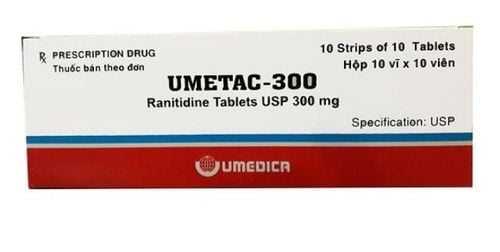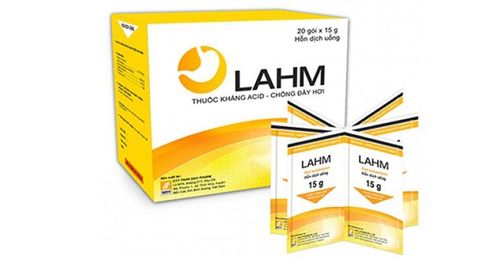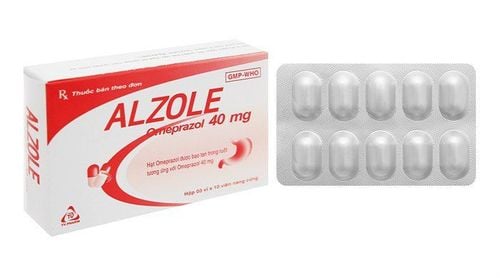This is an automatically translated article.
Rugastro 20 is used in the treatment of gastroesophageal reflux disease - oesophagitis, combined with an appropriate antibacterial regimen to eradicate Helicobacter pylori bacteria or heal gastric ulcers caused by non-steroidal anti-inflammatory drugs... Learn some information about uses, doses and precautions when using Rugastro to help patients use the drug safely and effectively.
1. What is Rugastro 20?
Rugastro 20 belongs to the group of gastrointestinal drugs, made in the form of hard capsules, containing the main active ingredient is Esomeprazole (as Esomeprazol magnesium dihydrate) 20mg. Esomeprazole sodium is the S-isomer of omeprazole, which reduces gastric acid secretion by a specific mechanism of action. Esomeprazole sodium is a specific inhibitor of the parietal cell acid pump. Both the R- and S- isomers of omeprazole have similar pharmacodynamic effects. Esomeprazole sodium is commonly indicated in the treatment of gastroesophageal reflux disease in people with esophagitis or severe reflux symptoms when other oral therapies are not suitable.
2. Indications for taking Rugastro 20
Rugastro 20 is indicated for the following cases:
Treatment of gastroesophageal reflux disease (GERD): Treatment of esophagitis caused by reflux; Long-term treatment in patients with healed esophagitis to prevent recurrence; Symptomatic treatment of gastroesophageal reflux disease (GERD). Combined with appropriate antibacterial regimen to eradicate Helicobacter pylori: Heal duodenal ulcers infected with Helicobacter pylori; Prevention of peptic ulcer recurrence in patients infected with Helicobacter pylori. Patients needing continuous treatment with non-steroidal anti-inflammatory drugs: Healing of stomach ulcers caused by taking non-steroidal anti-inflammatory drugs; Prevention of gastric and duodenal ulcers associated with the use of nonsteroidal anti-inflammatory drugs in patients at risk. Long-term use after intravenous treatment to prevent re-bleeding from peptic ulcers. Treatment of Zollinger-Ellison syndrome.
3. Dosage, how to use Rugastro 20
Reference Rugastro dose is as follows:
Treatment of duodenal ulcer: Use Rugastro dose 20mg/day x 2-4 weeks. Treatment of gastric ulcer and reflux esophagitis: Rugastro dose 20mg/day x 4-8 weeks. The dose of Rugastro 40 mg/day may be increased in patients resistant to other therapies. Treatment of Zollinger-Ellison syndrome: Use a dose of Rugastro 60mg/day. Prophylaxis of gastric and duodenal ulcer recurrence: Use Rugastro 20-40mg/day. Note: The above dose of Rugastro 20 is for reference only. The specific dose of Rugastro 20 will depend on the condition and the progression of the disease. To get the right dose of Rugastro 20, patients need to consult their doctor/pharmacist.
4. Contraindications to taking Rugastro
Do not use Rugastro 20 in people with a history of hypersensitivity to the active ingredient Esomeprazole, the Benzimidazole subgroup or other ingredients in the formula.
Contraindication is understood as an absolute contraindication, which means that for any reason the contraindication is not flexible enough to take Rugastro.
5. Drug interactions
Esomeprazole in Rugastro inhibits CYP2C19, the main enzyme that metabolizes Esomeprazole. Therefore, when co-administering Esomeprazole with drugs metabolised by CYP2C29 such as Imipram, Imipramine, Diazepam, Citalopam, Clomipramine, Phenytoin... the plasma concentrations of these drugs may increase and the dose should be reduced.
To avoid unwanted interactions when using Rugastro 20, patients should inform their doctor/pharmacist of all medicines, dietary supplements, vitamins and herbs... they are taking.
6. Side effects of Rugastro 20
Common side effects:
Headache; Abdominal pain, diarrhea, flatulence; Nausea/vomiting; Constipation. Uncommon side effects:
Dermatitis; Itching, hives; Dizzy; Dry mouth. Rare side effects:
Hypersensitivity reactions such as angioedema; Anaphylactic reactions; Increase liver enzymes. Other adverse reactions:
Paresthesia; Drowsiness, insomnia; Dizzy; Mental confusion, agitation, temper; Depression and hallucinations; Gynecomastia; Stomatitis, gastrointestinal candidiasis; Decrease in white blood cells, platelets; Agranulocytosis; Whole blood cell reduction; Increased liver enzymes, hepatic encephalopathy; Hepatitis with or without jaundice; Liver failure. Musculoskeletal pain, muscle weakness; Light sensitivity; Erythema multiforme ; Stevens-Johnson syndrome; Toxic epidermal necrolysis (TEN); Hair loss. Tired; Angioedema, fever; Bronchospasm ; Interstitial nephritis; Increased sweating; Peripheral edema; Blurred vision; Taste disorder; Decreased blood sodium. If there are any abnormal symptoms suspected of using Rugastro, the patient should notify the treating doctor/pharmacist for timely treatment.
7. Note when using Rugastro 20
When using Rugastro 20, the following should be noted:
Use Rugastro with caution in pregnant and lactating women; Malignancy should be excluded in cases of suspected gastric ulcer. The basic information about Rugastro 20 in the above article is for reference only. Because Rugastro 20 is a prescription drug, patients should not use it on their own, it is necessary to contact a specialist directly for a suitable prescription to ensure safety for health.













